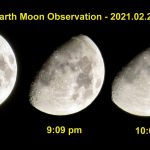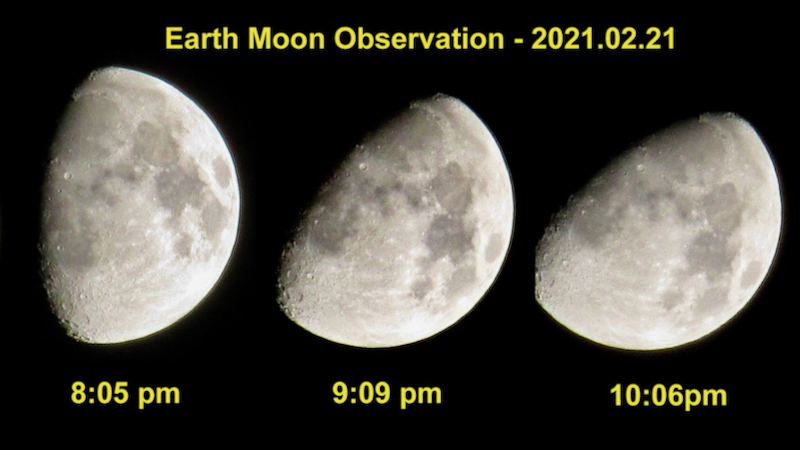

View at EarthSky Community Photos. | This is a crop of an image taken by Andy Bentley in Mountainview, California, showing the moon on a single night, February 21, 2021. See the full image here. The image shows how the moon’s orientation to your horizon changes, as you watch it sweep across the night sky. As you might know, the moon’s orientation in your sky also changes as you move in latitude, northward or southward, on Earth’s globe. Thanks, Andy!
Everyone looking up at the moon from any spot on the globe sees the same moon, in more or less the same phase. Moon phase is a whole-Earth phenomenon. So why does a photo of the moon taken from one part of the world look different from one taken in another part of the world, on the same night? And why does the moon seem to look different – even from the same spot – over the course of a single night?
Let’s take the second question first. The moon’s orientation with respect to your horizon shifts throughout the night because we live under a curved dome of sky. The illustration below – by C. Seligman – shows the curved line traveled by the stars and the moon, as they traverse Earth’s dome of night (or day). Professor Seligman was also trying to illustrate in this drawing that, although Earth’s rotation under the sky causes the stars and moon to move westward throughout the night, the moon’s motion in orbit is eastward.

The stars and moon travel on curved lines across Earth’s sky. That’s why the moon’s orientation with respect to your horizon changes throughout the night, as the photos above and below show. Illustration by C. Seligman.

Bridget Borchert in Bloomington, Minnesota, captured this image in 2018. She wrote: “The tilt of the moon through the evening fascinates me.”
So the moon looks different throughout the night, due to the moon’s arcing path across our sky. But what about the moon phases? Are they the same for all of us?
An important point to take into consideration is that those in the Northern and Southern Hemispheres also see the moon oriented differently from one another, with respect to the horizon. The change in orientation leads to differences that can be hard to comprehend! For one thing, observers in the Northern and Southern Hemispheres see the moon apparently upside-down with respect to each other. You can see that if you scrutinize the moon’s features in the images below. Notice that from the Northern Hemisphere, a waxing moon (from new moon to full moon) increases its phase from right to left.

Northern Hemisphere. Image via primaryhomeworkhelp.co.uk.
From the Southern Hemisphere, meanwhile, a waxing moon (from new moon to full moon) increases its phase from left to right.
Why so different? Think of the moon’s path across your sky. Just picture yourself standing there, looking at it. From the Northern Hemisphere, we look generally southward to see the moon (or sun) crossing our sky. From the Southern Hemisphere, people look generally northward to see the moon (or sun) crossing the sky.
Can you see why that shift in your orientation on the globe would cause you to see the moon differently?

Southern Hemisphere. Image via primaryhomeworkhelp.co.uk.
A final thought. What we on Earth call moon phases are really about sunrise and sunset on the moon. Astronomers call the line between light and dark on the moon the terminator line. That’s the line of sunrise or sunset on the moon, and it shifts, just as the line of sunrise and sunset on Earth is constantly shifting. Earth spins relatively fast, approximately once every 24 hours. The moon spins on its axis only once each earthly month, and its line of sunrise/set moves slowly. It’s wonderful fun to beg or borrow a telescope for a night when the moon is up … and watch for yourself over several hours as the shadows slowly shift on the moon, as the lunar sunrise or sunset slowly creeps across the moon’s face.
A great way to clear the mind!

View larger. | Mark Seibold caught the progression of shadows and light on crater rims and floors – across about 1 1/2 hours – at lunar sunrise (along the terminator line, or line between light and dark on the moon) on a 7-day-old moon on April 22, 2018. The large crater here is 95-mile-wide (150-km-wide) Ptolemaeus. Celestron Nexstar 5i, with Sony NEX5R directly through telescope, and 12.4mm Meade eyepiece projection.

Flickr user Mike O’Hara kindly labeled the wealth of named features along the moon’s terminator line – line of sunrise – on a waxing moon. If you had a telescope, as the line of sunrise slowly shifts, you could watch over several hours to see the shadows playing along the rims of these and many other lunar mountains and craters.
Bottom line: The moon shows one phase to the Earth at the same time, but our different perspectives due to where we are on the globe can make the moon appear differently in our sky.
Want more? Visit this page at primaryhomeworkhelp.co.uk
from EarthSky https://ift.tt/2PMSgTl


View at EarthSky Community Photos. | This is a crop of an image taken by Andy Bentley in Mountainview, California, showing the moon on a single night, February 21, 2021. See the full image here. The image shows how the moon’s orientation to your horizon changes, as you watch it sweep across the night sky. As you might know, the moon’s orientation in your sky also changes as you move in latitude, northward or southward, on Earth’s globe. Thanks, Andy!
Everyone looking up at the moon from any spot on the globe sees the same moon, in more or less the same phase. Moon phase is a whole-Earth phenomenon. So why does a photo of the moon taken from one part of the world look different from one taken in another part of the world, on the same night? And why does the moon seem to look different – even from the same spot – over the course of a single night?
Let’s take the second question first. The moon’s orientation with respect to your horizon shifts throughout the night because we live under a curved dome of sky. The illustration below – by C. Seligman – shows the curved line traveled by the stars and the moon, as they traverse Earth’s dome of night (or day). Professor Seligman was also trying to illustrate in this drawing that, although Earth’s rotation under the sky causes the stars and moon to move westward throughout the night, the moon’s motion in orbit is eastward.

The stars and moon travel on curved lines across Earth’s sky. That’s why the moon’s orientation with respect to your horizon changes throughout the night, as the photos above and below show. Illustration by C. Seligman.

Bridget Borchert in Bloomington, Minnesota, captured this image in 2018. She wrote: “The tilt of the moon through the evening fascinates me.”
So the moon looks different throughout the night, due to the moon’s arcing path across our sky. But what about the moon phases? Are they the same for all of us?
An important point to take into consideration is that those in the Northern and Southern Hemispheres also see the moon oriented differently from one another, with respect to the horizon. The change in orientation leads to differences that can be hard to comprehend! For one thing, observers in the Northern and Southern Hemispheres see the moon apparently upside-down with respect to each other. You can see that if you scrutinize the moon’s features in the images below. Notice that from the Northern Hemisphere, a waxing moon (from new moon to full moon) increases its phase from right to left.

Northern Hemisphere. Image via primaryhomeworkhelp.co.uk.
From the Southern Hemisphere, meanwhile, a waxing moon (from new moon to full moon) increases its phase from left to right.
Why so different? Think of the moon’s path across your sky. Just picture yourself standing there, looking at it. From the Northern Hemisphere, we look generally southward to see the moon (or sun) crossing our sky. From the Southern Hemisphere, people look generally northward to see the moon (or sun) crossing the sky.
Can you see why that shift in your orientation on the globe would cause you to see the moon differently?

Southern Hemisphere. Image via primaryhomeworkhelp.co.uk.
A final thought. What we on Earth call moon phases are really about sunrise and sunset on the moon. Astronomers call the line between light and dark on the moon the terminator line. That’s the line of sunrise or sunset on the moon, and it shifts, just as the line of sunrise and sunset on Earth is constantly shifting. Earth spins relatively fast, approximately once every 24 hours. The moon spins on its axis only once each earthly month, and its line of sunrise/set moves slowly. It’s wonderful fun to beg or borrow a telescope for a night when the moon is up … and watch for yourself over several hours as the shadows slowly shift on the moon, as the lunar sunrise or sunset slowly creeps across the moon’s face.
A great way to clear the mind!

View larger. | Mark Seibold caught the progression of shadows and light on crater rims and floors – across about 1 1/2 hours – at lunar sunrise (along the terminator line, or line between light and dark on the moon) on a 7-day-old moon on April 22, 2018. The large crater here is 95-mile-wide (150-km-wide) Ptolemaeus. Celestron Nexstar 5i, with Sony NEX5R directly through telescope, and 12.4mm Meade eyepiece projection.

Flickr user Mike O’Hara kindly labeled the wealth of named features along the moon’s terminator line – line of sunrise – on a waxing moon. If you had a telescope, as the line of sunrise slowly shifts, you could watch over several hours to see the shadows playing along the rims of these and many other lunar mountains and craters.
Bottom line: The moon shows one phase to the Earth at the same time, but our different perspectives due to where we are on the globe can make the moon appear differently in our sky.
Want more? Visit this page at primaryhomeworkhelp.co.uk
from EarthSky https://ift.tt/2PMSgTl

Aucun commentaire:
Enregistrer un commentaire